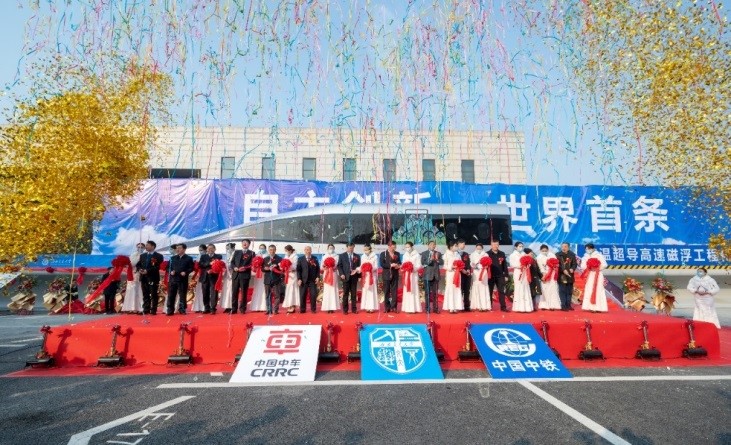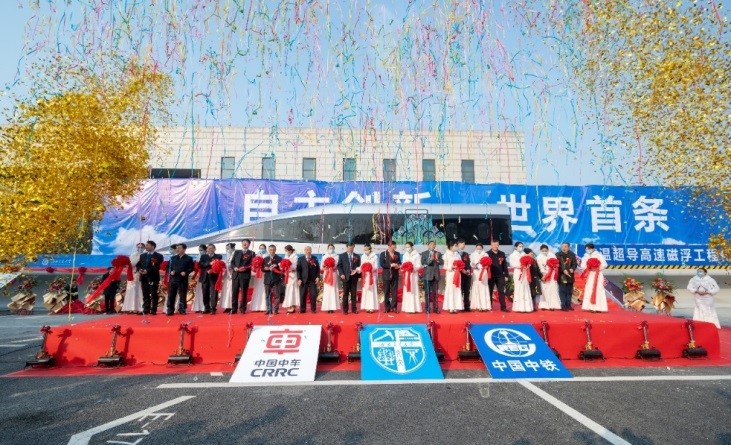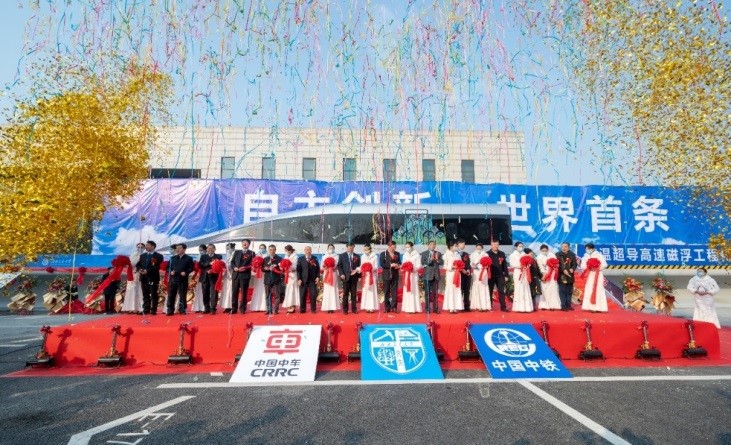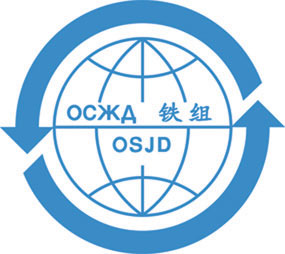The world's first super-high-speed Maglev train prototype using high-temperature superconductivity technology designed and manufactured in China (according to the information of the Southwest Jiaotong University)



On 13 January 2021, the city of Chengdu (China, Sichuan province) witnessed the official launch of the world’s first technical prototype of a high-speed magnetic levitation (Maglev) train using high-temperature superconductivity, as well as a track line to test the new train. The prototype has been developed using the original technologies of the Southwest Jiaotong University (SWJU, an OSJD affiliated enterprise).
The new technologies, which have allowed the creation of pilot conditions for technical testing, are breakthrough in the field of transport for high-speed magnetic levitation trains using high-temperature superconductivity.
The technical prototype and the test track are located on the territory of the Southwest Jiaotong University. The total length of the test track is 165 m, and a land area of about 1250 m2 was allocated to create a test complex, which provides for the development of a technical prototype, a levitation system, a traction and braking system, a traffic control system, underground and auxiliary engineering structures, as well as a system of integrated testing and monitoring. The test center provides all the basic conditions for testing the prototype of a high-speed magnetic levitation train with high-temperature superconductivity, including levitation, control, traction and braking, as well as the ability to conduct comprehensive tests and commissioning of the entire system facility, which meets the requirements for research and development work in subsequent stages.
The official launching ceremony of the technical prototype was attended by Yang Dan, Rector of the Southwest Jiaotong University, and Wang Shunhong, Secretary of the University Party Committee, who have announced the official launch of the technical prototype of a high-speed magnetic levitation train using high-temperature superconductivity technology. as well as the track line to test the new train. Outstanding scientists from the Southwest Jiaotong University took part in the ceremony of cutting the red ribbon: Academician of the Chinese Academy of Sciences and the Chinese Academy of Engineering Sciences Shen Zhiyun, Academician of the Chinese Academy of Engineering Sciences Qian Qingquan, Professor Wang Suyu, as well as heads of various institutions and organisations, including the Sichuan Department of Science and Technology, the Chengdu City Science and Technology Bureau, the Yunnan Provincial Development and Reforming Committee, as well as CRRC Tangshan Co., Ltd. The event was also attended by representatives of the CREC Corporation, China Transport Construction Corporation, CRRC Corporation, CRRC Zhuzhou Electric Co., Ltd., CREC Second Department and Third Department, China State Railway Investment Construction Group Co., Ltd. and China Railway Maglev Transportation Investment Construction Co., Ltd., representatives of the Southwest Jiaotong University Design Institute and the Southwest Jiaotong University Research Group led by Professor Zhang Weihua.
The technology of the magnetic levitation train with high-temperature superconductivity originated at the Southwest Jiaotong University.
In 2000, the world's first manned experimental magnetic levitation train with high-temperature superconductivity was successfully developed, which was included in the ranking of the 10 most significant achievements of scientific and technological progress among the universities of the PRC. In 2004, a solution for a magnetic levitation transport system with a speed of over 600 km/h was presented. In 2013, the first ring test track in China for the movement of a Maglev train with high-temperature superconductivity was developed and built, which at that time was a levitation system with an identical lifting force in relation to world analogues, but having the smallest section and requiring the smallest volume of permanent magnet.
In 2019, a vacuumconducting experimental platform was created for the movement of a high-speed magnetic levitation train with high-temperature superconductivity, and the maximum experimental speed reached 400 km/h.
This platform has enabled research into the dynamics, aerodynamics, vibration and noise of a magnetic levitation train with high temperature superconductivity.
In 2020, the Southwest Jiaotong University in cooperation with CRRC Tangshan Co., Ltd., CRRC Zhuzhou Electric Co., Ltd. and CREC's Second Directorate conducted research on the implementation of a technical prototype and test track for a magnetic levitation train with high temperature superconductivity. The train design uses a number of new technologies, including safe rail wrap design, high temperature superconducting magnetic levitation technology for high loads, long stator permanent magnet synchronous linear motors, lightweight coach body made of all carbon fiber, reducing drag, head coach shape and integration eddy current brake and safe control.
The technology engineering of the magnetic levitation train with high-temperature super-conductivity is planned to be carried out at the first stage in an atmospheric environment, in which the target designation of the train speed is expected to be increased to more than 600 km/h. At the next stage, it is planned to use vacuum pipe technology and create a basis for the implementation in the long term of a project with a speed of more than 1000 km/h.
